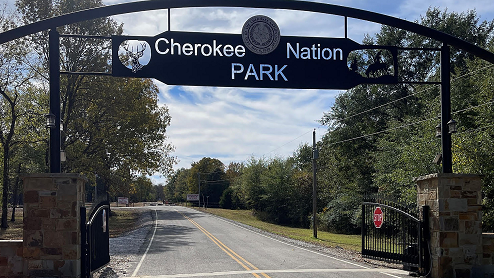
- Details
- By Chuck Hoskin Jr
Guest Opinion. The Cherokee people have always been deeply connected to the land. Since time immemorial, we have depended on the land for food and medicine, natural beauty, and the perfect setting for Cherokee community life and cultural activities. From our ancient homelands in the southeast to our reservation in northeast Oklahoma, the land has always been essential for our collective well-being.
In close collaboration with Deputy Chief Bryan Warner, the Council of the Cherokee Nation and our Secretary of Natural Resources Chad Harsha, I have worked to be a responsible steward of Cherokee land, balancing acquisition, development and conservation.
The Cherokee Nation Park, Wildlands, Fishing and Hunting Preserve Act of 2021 improved how we manage tribal lands, emphasizing public access to parks and conservation. We set aside over 6,000 acres of tribal lands in northeast Oklahoma to support outdoor activities, conservation and traditional practices. Thanks to this act, we are able to host more events, offer more educational experiences, and provide more opportunities for Cherokee families to enjoy the great outdoors.
Recently, we broke ground on the expansion of the Cherokee Nation Park at Sallisaw Creek in Sequoyah County. We are developing a 100-acre area within the 1,300-acre property. Phase 1 will include infrastructure improvements, an expanded tournament-style boat ramp, a few cabins and 74 RV hookup spaces. This will be a destination for local citizens and tourists alike and further showcase the beauty of our reservation lands. Once completed, it will be open to the public for day-use, boating, horseback riding and limited hunting.
Also in Sequoyah County, we are proud to have opened Cherokee Nation’s first hunting and fishing preserve. The 4,300-acre preserve is already being used for hunts and actively managed for conservation by our Natural Resources Department. The preserve and these programs have benefitted numerous Cherokees citizens, both those who live on the reservation and visiting at-large citizens, with special opportunities for our veterans, elders and youth to enjoy the beauty of our reservation.

Two more locations of note include the Medicine Keepers’ Preserve and the Shawnee Preserve, which have both been set aside for cultural purposes. Medicine Keepers’ Preserve is a 1,000-acre site in Adair County rich with plants historically important to Cherokee traditions and culture. It is set aside for our Medicine Keepers, a group of fluent Cherokee-speaking elders who are dedicated to perpetuating the Cherokee language and knowledge of plants and sacred places. At the Shawnee Preserve,155 acres in Craig County are being held for cultural use by the Shawnee Tribe. This land is adjacent to our sister tribe’s ceremonial grounds, which makes it ideal for Shawnee traditional use.
Finally, we have begun work on the future Wilma P. Mankiller Park, a public park on Cherokee land near the W.W. Keeler Complex in Tahlequah. When completed in two years, this more than 6-acre park will include a community building, unique landscaping, public art, a playground and a statue of Chief Mankiller.
We are taking a thoughtful approach to the way we manage our land today so that generations from now Cherokees will continue to enjoy its beauty, resources and cultural lessons. The land is our shared responsibility, and, when we manage it carefully, it is a shared blessing for the Cherokee people.
Chuck Hoskin, Jr. is the principal chief of the Cherokee Nation.
More Stories Like This
Evidence, Not Emotion Protects Tribal SovereigntyWho Gets Hurt When SNAP Benefits are Stopped?
Expanding Food Security and Protecting Cherokee Elders
Governor Stitt, it’s raining. Save SNAP.
Remembering My Grandma During Native American Heritage Month
Help us tell the stories that could save Native languages and food traditions
At a critical moment for Indian Country, Native News Online is embarking on our most ambitious reporting project yet: "Cultivating Culture," a three-year investigation into two forces shaping Native community survival—food sovereignty and language revitalization.
The devastating impact of COVID-19 accelerated the loss of Native elders and with them, irreplaceable cultural knowledge. Yet across tribal communities, innovative leaders are fighting back, reclaiming traditional food systems and breathing new life into Native languages. These aren't just cultural preservation efforts—they're powerful pathways to community health, healing, and resilience.
Our dedicated reporting team will spend three years documenting these stories through on-the-ground reporting in 18 tribal communities, producing over 200 in-depth stories, 18 podcast episodes, and multimedia content that amplifies Indigenous voices. We'll show policymakers, funders, and allies how cultural restoration directly impacts physical and mental wellness while celebrating successful models of sovereignty and self-determination.
This isn't corporate media parachuting into Indian Country for a quick story. This is sustained, relationship-based journalism by Native reporters who understand these communities. It's "Warrior Journalism"—fearless reporting that serves the 5.5 million readers who depend on us for news that mainstream media often ignores.
We need your help right now. While we've secured partial funding, we're still $450,000 short of our three-year budget. Our immediate goal is $25,000 this month to keep this critical work moving forward—funding reporter salaries, travel to remote communities, photography, and the deep reporting these stories deserve.
Every dollar directly supports Indigenous journalists telling Indigenous stories. Whether it's $5 or $50, your contribution ensures these vital narratives of resilience, innovation, and hope don't disappear into silence.
 The stakes couldn't be higher. Native languages are being lost at an alarming rate. Food insecurity plagues many tribal communities. But solutions are emerging, and these stories need to be told.
The stakes couldn't be higher. Native languages are being lost at an alarming rate. Food insecurity plagues many tribal communities. But solutions are emerging, and these stories need to be told.
Support independent Native journalism. Fund the stories that matter.
Levi Rickert (Potawatomi), Editor & Publisher
